Asymmetric Drain Extension Dual-kk Trigate Underlap FinFET Based on RF/Analog Circuit
Abstract
:1. Introduction
2. Asymmetric Dual-kk Trigate FinFET Structure and Performance Study
3. Design and Analysis of RF/Analogy Performance of AsymD-kk FinFET
3.1. Fin Height (Hfin)
3.2. Fin Width (Wfin)
3.3. Source/Drain Extension Length (Lext)
3.4. Inner High-k Spacer Length (Lhk)
4. Asymmetric Drain Extension Dual-kk Trigate Underlap FinFET (AsymD-kkDE)
5. Conclusions
Acknowledgments
Author Contributions
Conflicts of Interest
References
- Intel’s 14 nm Technology: Intel’s Custom Chips Highlight Company’s 14 nm Process. Available online: https://www.eetimes.com/document.asp?doc_id=1321621 (accessed on 15 September 2017).
- Kranti, A.; Armstrong, G.A. Source/drain extension region engineering in FinFETs for low-voltage analog applications. IEEE Electron Device Lett. 2007, 28, 139–141. [Google Scholar] [CrossRef]
- Nandi, A.; Chandel, R. Design and analysis of sub-DT sub-domino logic circuits for ultra-low power applications. J. Low Power Electron. 2010, 6, 513–520. [Google Scholar] [CrossRef]
- The International Technology Roadmap for Semiconductors. Available online: http://www.itrs2.net/ (accessed on 4 October 2017).
- Chi, M.H. FinFET technology: Overview and status at 14nm node and beyond. In Proceedings of the Semiconductor Technology International Conference (CSTIC), Shanghai, China, 13–14 March 2016; pp. 1–3. [Google Scholar]
- Gopal, M.; Vishvakarma, S.K. Effect of asymmetric doping on asymmetric underlap Dual-k spacer FinFET. In Proceedings of the 2015 Annual IEEE India Conference (INDICON), New Delhi, India, 17–20 December 2015; pp. 1–4. [Google Scholar]
- Trivedi, V.; Fossum, J.G.; Chowdhury, M.M. Nanoscale FinFETs with gate-source/drain underlap. IEEE Trans. Electron Devices 2005, 52, 56–62. [Google Scholar]
- Vega, R.A.; Liu, K.; Liu, T.J.K. Dopant-Segregated Schottky Source/Drain Double-Gate MOSFET design in the direct source-to-drain tunneling regime. IEEE Trans. Electron Devices 2009, 56, 2016–2026. [Google Scholar] [CrossRef]
- Sachid, A.B.; Chen, M.C.; Hu, C. FinFET with high-k spacers for improved drive current. IEEE Electron Device Lett. 2016, 37, 835–838. [Google Scholar]
- Manoj, C.R.; Rao, V.R. Impact of High-k Gate Dielectrics on the device and circuit performance of nanoscale FinFETs. IEEE Electron Device Lett. 2007, 28, 295–297. [Google Scholar] [CrossRef]
- Pal, P.K.; Kaushik, B.K.; Dasgupta, S. Investigation of symmetric Dual-k spacer trigate FinFETs from delay perspective. IEEE Trans. Electron Devices 2014, 61, 3579–3585. [Google Scholar] [CrossRef]
- Pal, P.K.; Kaushik, B.K.; Dasgupta, S. A detailed capacitive analysis of symmetric and asymmetric Dual-k FinFETs for improved circuit delay metrics. In Proceedings of the 2016 Conference on Emerging Devices and Smart Systems (ICEDSS), Namakkal, India, 4–5 March 2016; pp. 13–18. [Google Scholar]
- Vega, R.A.; Liu, T.J.K. Comparative study of FinFET versus quasi-planar HTI MOSFET for ultimate scalability. IEEE Trans. Electron Devices 2010, 57, 3250–3256. [Google Scholar] [CrossRef]
- Singh, J.; Bousquet, A.; Ciavatti, J.; Sundaram, K.; Wong, J.S.; Chew, K.W.; Bandyopadhyay, A.; Li, S.; Bellaouar, A.; Pandey, S.M.; et al. 14nm FinFET technology for analog and RF applications. In Proceedings of the 2017 IEEE Symposium on VLSI Technology, Kyoto, Japan, 5–8 June 2017; pp. T140–T141. [Google Scholar]
- Tinoco, J.C.; Rodriguez, S.S.; Martinez-Lopez, A.G.; Alvarado, J.; Raskin, J.P. Impact of extrinsic capacitances on FinFET RF performance. IEEE Trans. Microw. Theory Technol. 2013, 61, 833–840. [Google Scholar] [CrossRef]
- Subramanian, V.; Mercha, A.; Parvais, B.; Dehan, M.; Groeseneken, G.; Sansen, W.; Decoutere, S. Identifying the bottlenecks to the RF performance of FinFETs. In Proceedings of the 23rd International Conference on VLSI Design, Bangalore, India, 3–7 January 2010; pp. 111–116. [Google Scholar]
- Sun, X.; Moroz, V.; Damrongplasit, N.; Shin, C.; Liu, T.J.K. Variation study of the planar ground-plane bulk MOSFET, SOI FinFET, and trigate bulk MOSFET designs. IEEE Trans. Electron Devices 2011, 58, 3294–3299. [Google Scholar] [CrossRef]
- Sentaurus TCAD User’s Manual. Available online: http://www.synopsys.com/ (accessed on 25 May 2017).
- Pradhan, K.P.; Sahu, P.K.; Mohapatra, S.K. Analysis of symmetric high-k spacer (SHS) trigate wavy FinFET: A novel device. In Proceedings of the Annual IEEE India Conference (INDICON), New Delhi, India, 17–20 December 2015; pp. 1–3. [Google Scholar]
- Dixit, A.; Kottantharayil, A.; Collaert, N.; Goodwin, M.; Jurczak, M.; De Meyer, K. Analysis of the parasitic S/D resistance in multiple-gate FETs. IEEE Trans. Electron Devices 2005, 52, 1132–1140. [Google Scholar] [CrossRef]
- Wu, S.Y.; Lin, C.Y.; Chiang, M.C.; Liaw, J.J.; Cheng, J.Y.; Yang, S.H.; Liang, M.; Miyashita, T.; Tsai, C.H.; Hsu, B.C.; et al. A 16nm FinFET CMOS technology for mobile SoC and computing applications. In Proceedings of the 2013 IEEE International Electron Devices Meeting, Washington, DC, USA, 9–11 December 2013; pp. 9–11. [Google Scholar]
- Sachid, A.B.; Manoj, C.R.; Sharma, D.K.; Rao, V.R. Gate fringe-induced barrier lowering in underlap FinFET structures and its optimization. IEEE Electron Device Lett. 2008, 29, 128–130. [Google Scholar] [CrossRef]
- Mohapatra, S.K.; Pradhan, K.P.; Singh, D.; Sahu, P.K. The role of geometry parameters and fin aspect ratio of sub-20nm SOI-FinFET: An analysis towards analog and RF circuit design. IEEE Trans. Nanotechnol. 2015, 14, 546–554. [Google Scholar] [CrossRef]
- Lauerhaas, J.M.; Cleavelin, R.; Xiong, W.Z.; Mochizuki, K.; Sherman, K.; Lee, H.C.; Clappin, B.; Schulz, T.; Schruefer, K. Preparation, characterization, and damage-free processing of advanced multi-Gate FETs. Solid State Phenom. 2008, 134, 213–216. [Google Scholar] [CrossRef]
- Kranti, A.; Armstrong, G.A. Design and optimization of FinFETs for ultra-low-voltage analog applications. IEEE Trans. Electron Devices 2007, 54, 3308–3316. [Google Scholar] [CrossRef] [Green Version]
- Kranti, A.; Lim, T.C.; Armstrong, G.A. Source/drain extension region engineering in nanoscale double gate MOSFETs for low-voltage analog applications. In Proceedings of the 2006 IEEE International SOI Conferencee, Niagara Falls, NY, USA, 2–5 October 2006; pp. 141–142. [Google Scholar]
- Wu, W.; Chan, M. Analysis of geometry-dependent parasitics in multifin double-gate FinFETs. IEEE Trans. Electron Devices 2007, 54, 692–698. [Google Scholar] [CrossRef]
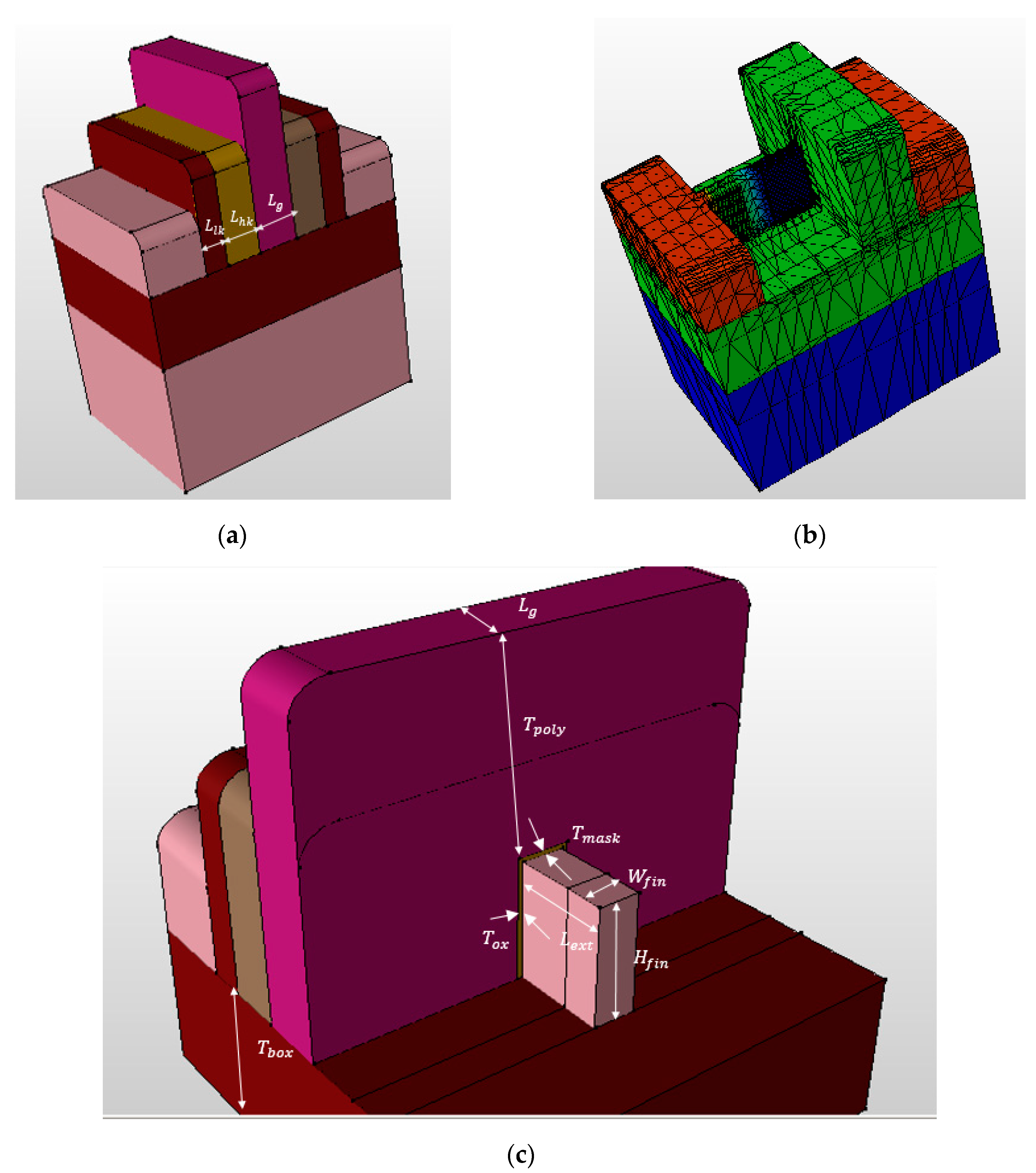
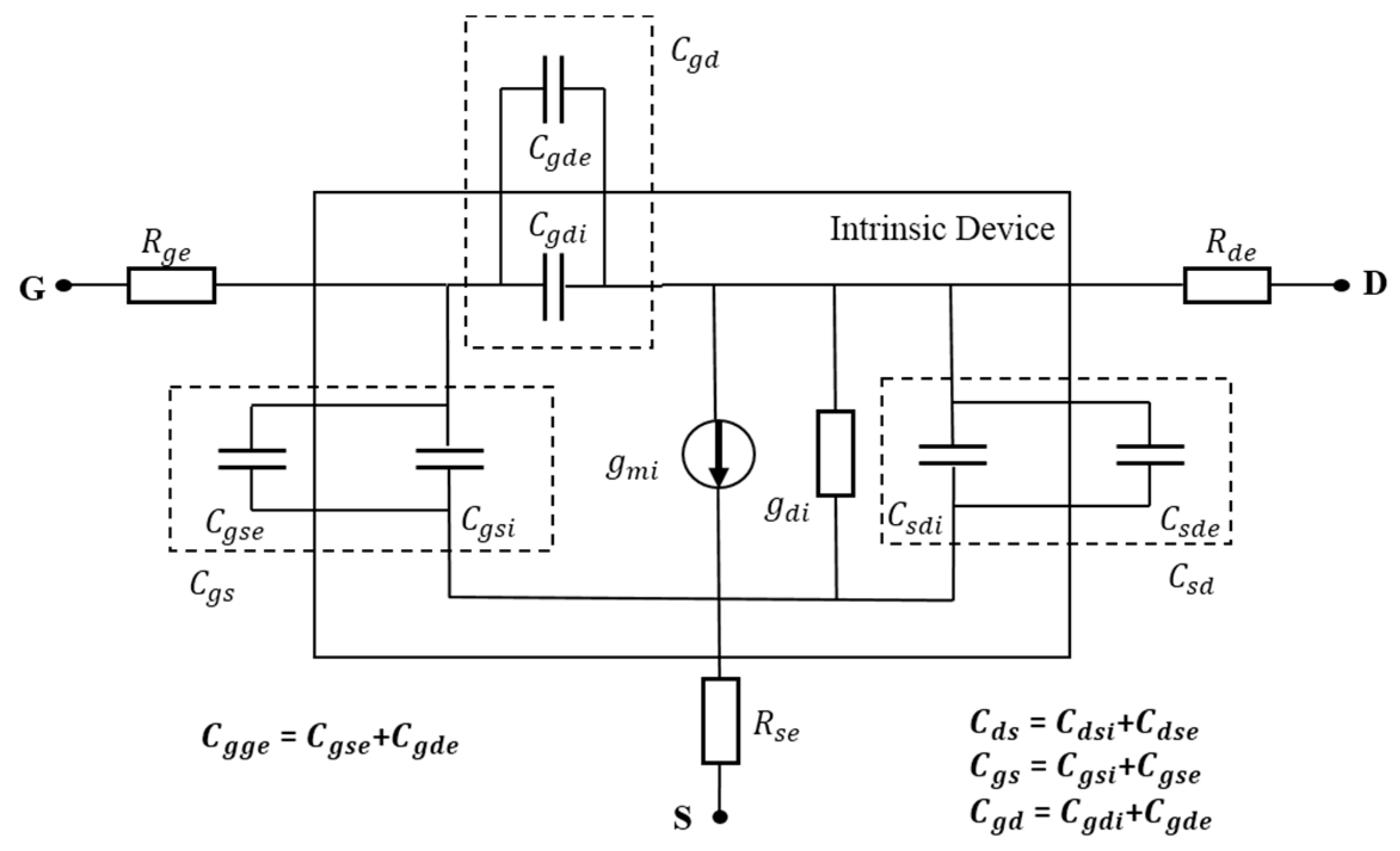
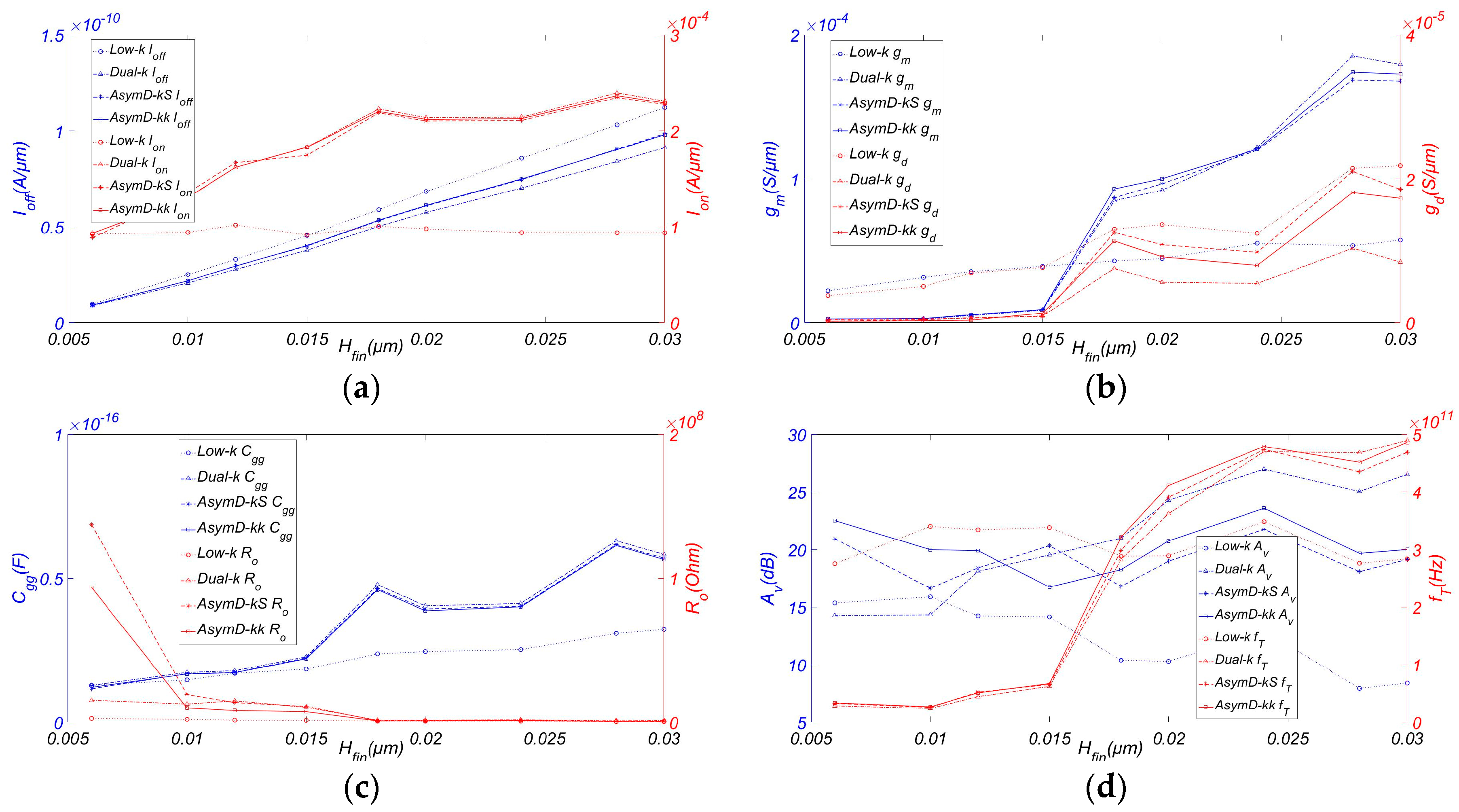
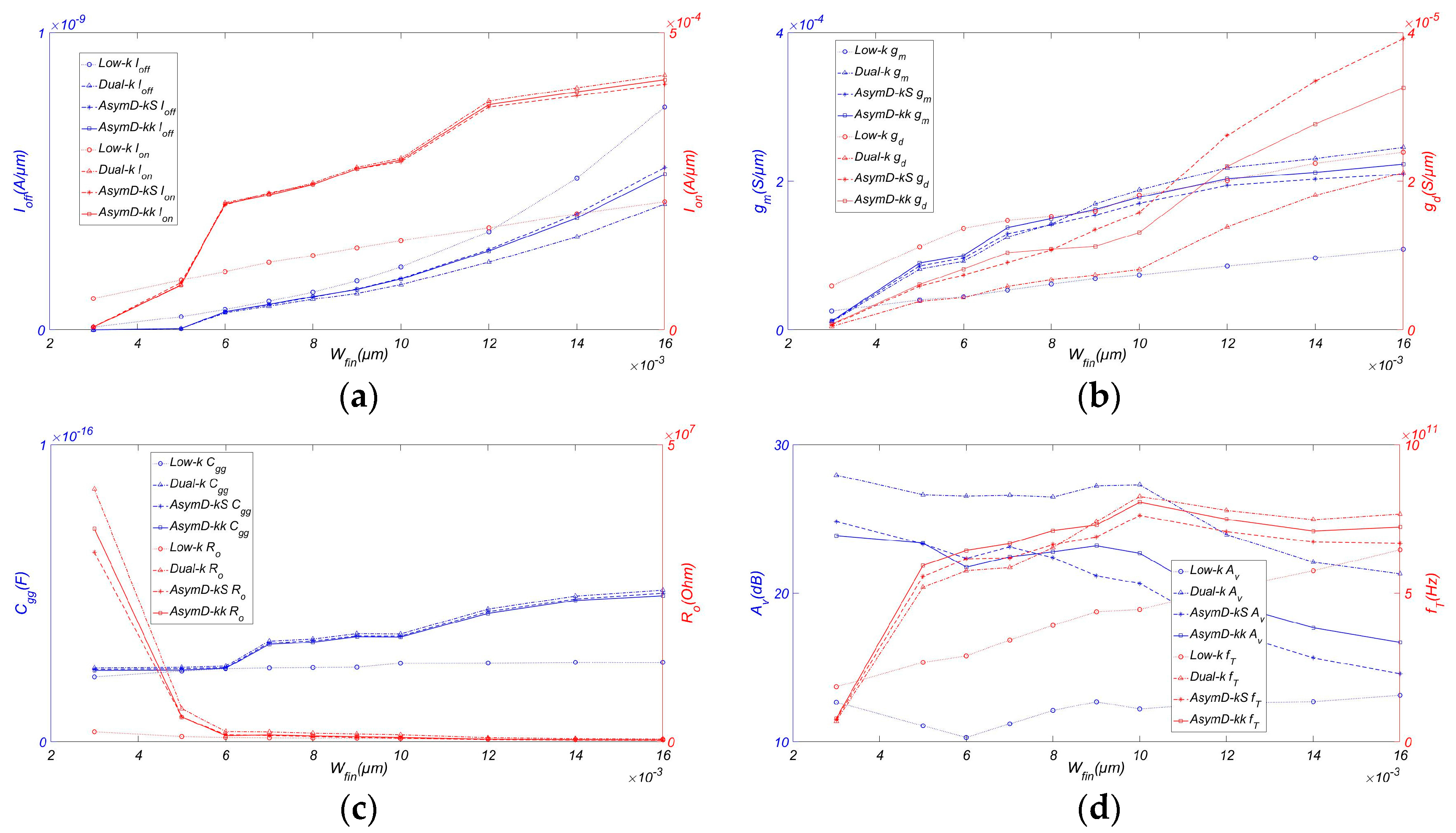
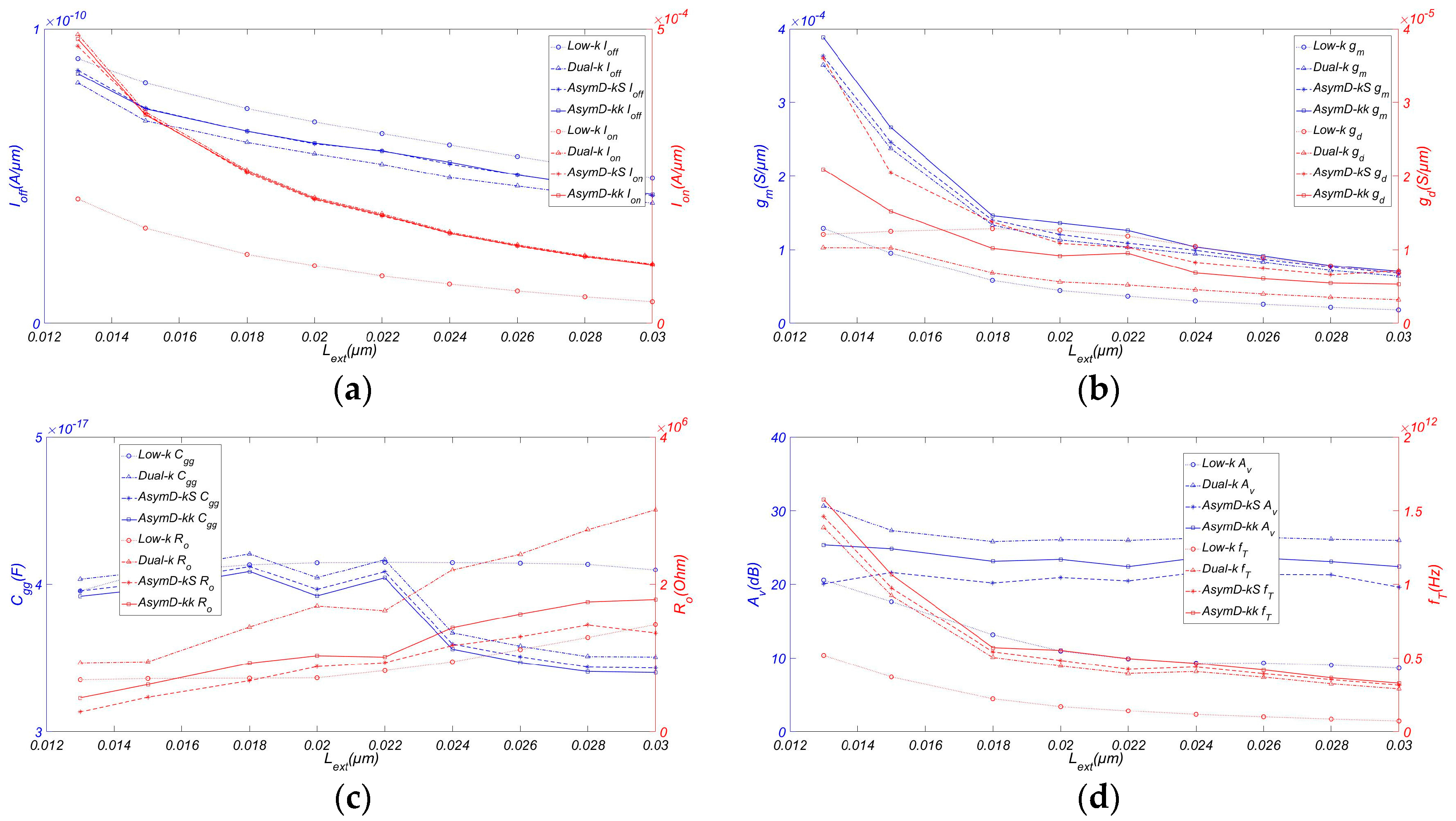
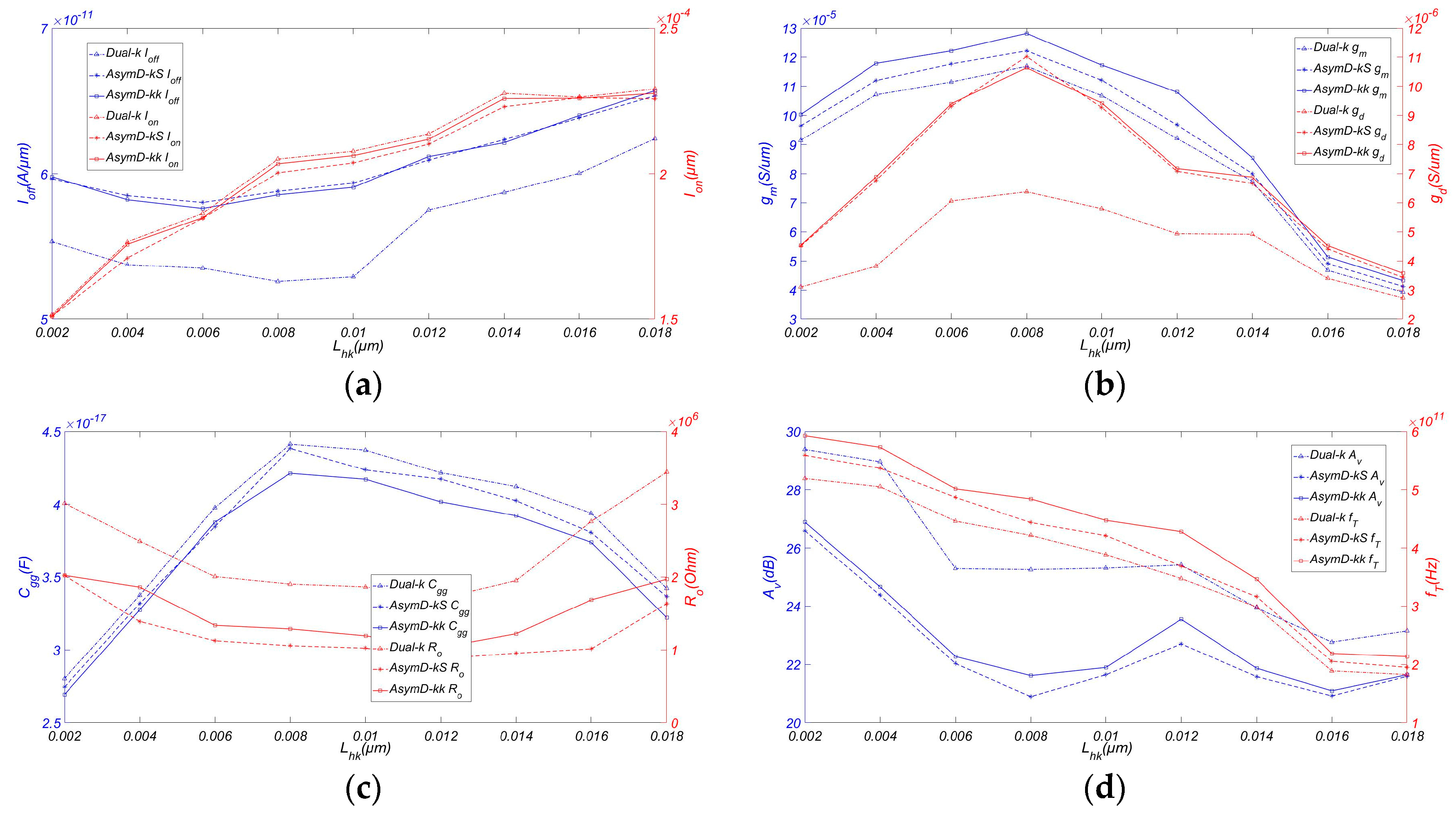
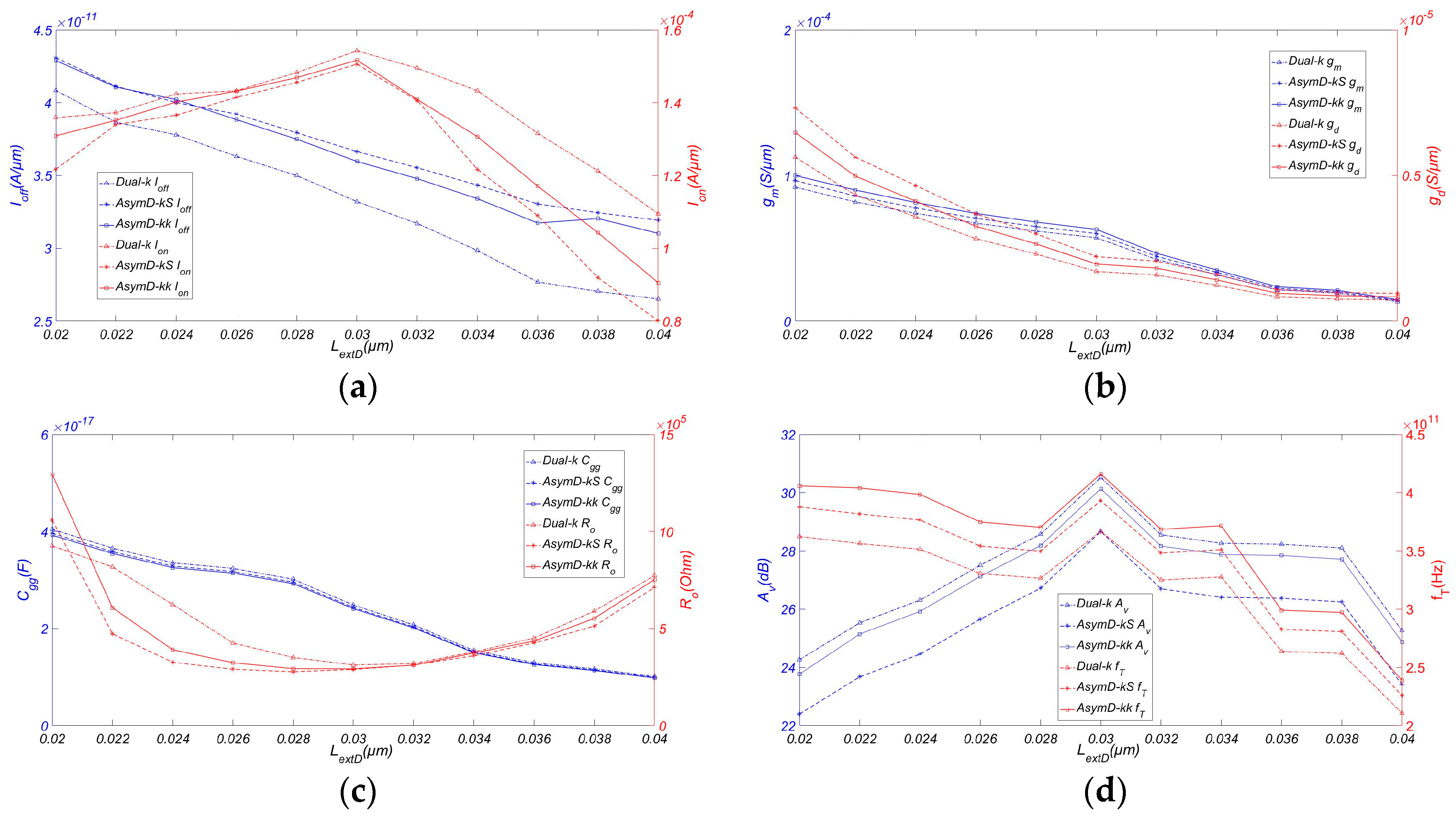
| Parameters | Description | Typical Value/nm |
|---|---|---|
| Lg | Gate length | 14 |
| Hfin | Fin height | 20 |
| Wfin | Fin width | 6 |
| Tmask | Hard mask thickness over fins | 0.8 |
| Tpoly | Geometrical thickness of gate material over hard mask | 15 |
| Tox | Thickness of gate oxide | 0.8 |
| Lext | Source/Drain extension length | 20 |
| Lhk | The inner high-k spacer length | 12 |
| Llk | outer low-k spacer length | 8 |
© 2017 by the authors. Licensee MDPI, Basel, Switzerland. This article is an open access article distributed under the terms and conditions of the Creative Commons Attribution (CC BY) license (http://creativecommons.org/licenses/by/4.0/).
Share and Cite
Han, K.; Qiao, G.; Deng, Z.; Zhang, Y. Asymmetric Drain Extension Dual-kk Trigate Underlap FinFET Based on RF/Analog Circuit. Micromachines 2017, 8, 330. https://doi.org/10.3390/mi8110330
Han K, Qiao G, Deng Z, Zhang Y. Asymmetric Drain Extension Dual-kk Trigate Underlap FinFET Based on RF/Analog Circuit. Micromachines. 2017; 8(11):330. https://doi.org/10.3390/mi8110330
Chicago/Turabian StyleHan, Ke, Guohui Qiao, Zhongliang Deng, and Yannan Zhang. 2017. "Asymmetric Drain Extension Dual-kk Trigate Underlap FinFET Based on RF/Analog Circuit" Micromachines 8, no. 11: 330. https://doi.org/10.3390/mi8110330





